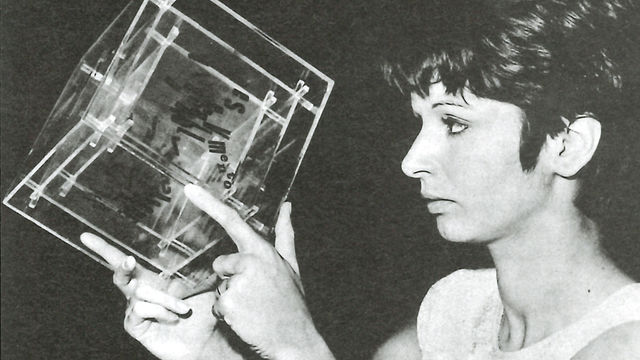
Neide Sá
Born in Rio de Janeiro in 1940, Neide Sá began to teach art to children in the 1960s and would continue to do so for the next two decades. During the 1970s and 1980s she took painting and printmaking classes at the Escola de Artes Visuais do Parque Lage and Museu de Arte Moderna do Rio de Janeiro. In 1980 she earned a degree in graphic design from the Pontifícia Universidade Católica do Rio de Janeiro. In 1983 Sá completed a postgraduate program in art education at the Instituto Metodista Bennett, also in Rio de Janeiro. Her art production, however, began prior to any formal training. In 1967 she was one of the founders—together with her husband, Álvaro de Sá (1935–2001); Wlademir Dias-Pino (b. 1927); and Moacy Cirne (1943–2014)—of the avant-garde movement Poema/Processo. The group challenged the semantic limitations of words by replacing them with images and visual signs. Officially ended in 1972, the movement at its height reached about 250 artists scattered throughout Brazil. The tension between concepts and signs investigated by Poema/Processo would remain important in Sá's art production as she explored graphic language in artist's books, objects, paintings, and installations.
Another important aspect of her work is the participation of the public to complete her pieces, always executed in a minimalist geometric aesthetic. This is evident, for example, in Sá's signature medium, the artist's book. Throughout her career she produced more than 150 of these pieces, starting with the 1969 series Onomatopeias. In the early 1970s the investigation of the book format led her to the first Livros vazados (Hollow books), collections of paper sheets with cutout geometric shapes that, when superimposed by manipulation, become new forms. At the same time she created interactive sculptures, such as Prismas (Prisms) and Circunferências (Circumferences), both from 1973. These objects are composed of series of small elements that are attached to a metal disk by magnets and can be rearranged by the viewer. During the 1980s Sá experimented with photogravure, a technique she expanded by including different textures on the paper surface, as in Relevo seco (Dry relief, 1983).
In the following decade Sá created works using sand mixed with acrylic paint in strong geometric compositions, first in contrasting bold primary colors—as in the Azuis/ Vermelho (Blues/Red) series—and later in monochrome or muted tones—as in the Amarelos (Yellows) series. Sá's characteristic preoccupation with public participation reached a new level in the 2000s with the realization of interactive performances such as Nós e nós (Knots and knots, 2004). The first of her many solo shows took place in 1980, at Galleria Il Brandale in Savona, Italy. The artist also participated in important group exhibitions, such as the 12th and 14th Bienals de São Paulo (1977, 1979) and 38th Venice Biennale (1978).
—Mariana von Hartenthal
Selected Solo Exhibitions
1980 Neide Sá: Livros-objeto, Galleria Il Brandale, Savona, Italy
1985 Neide Sá: Livros-objeto, Galeria Macunaíma, Rio de Janeiro
1993 Neide Sá: Livros-objeto, Galería Casa Jove, Barcelona
1998 Neide Dias de Sá: Revelação dos rastros, Museu de Arte, Porto Alegre, Brazil
2000 A ordem do caos, Museu Nacional de Belas Artes, Rio de Janeiro
Selected Bibliography
Chaves, Xico. Neide Dias de Sá: Revelação dos rastros. Rio de Janeiro: Ministerio da Cultura, Museu Nacional de Belas Artes, 1998.
Dias de Sá, Neide, and Mirella Bentivoglio. Neide Dias de Sá. Savona: Il Brandale, 1980.
Dias-Pino, Wlademir. Processo: Linguagem e comunicação. Petrópolis, Brazil: Vozes, 1971.
Margutti, Mário. Do poema visual ao objeto-poema: A trajetória de Neide Sá. Rio de Janeiro: Lacre, 2014.
Silveira, Paulo. A página violada: Da ternura à injúria na construção do livro de artista. Porto Alegre, Brazil: Editora da Universidade, Universidade Federal do Rio Grande do Sul, 2001.


